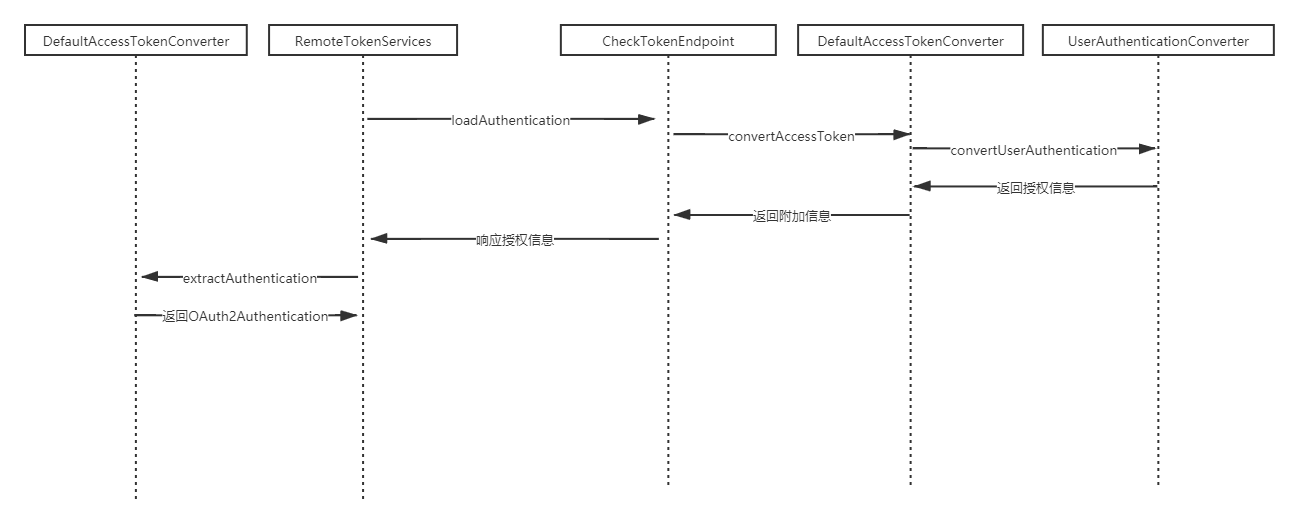丰富当前登录用户信息
资源服务器获取登录用户信息
获取登录用户信息代码
SecurityContextHolder.getContext().getAuthentication()资源服务器获取登录用户信息流程

从流程可以看出,关键的类是DefaultAccessTokenConverter、UserAuthenticationConverter,只要扩展这两个类,就能够放入更多信息。
授权服务自定义DefaultUserAuthenticationConverter
创建SpringUserAuthenticationConverter类继承DefaultUserAuthenticationConverter,重写convertUserAuthentication方法,放入更多用户相关的信息
public class SpringUserAuthenticationConverter extends DefaultUserAuthenticationConverter {
@Override
public Map<String, ?> convertUserAuthentication(Authentication authentication) {
Map<String, Object> response = new LinkedHashMap<String, Object>();
SpringUserDetails userDetails = (SpringUserDetails) authentication.getPrincipal();
response.put(USERNAME, authentication.getName());
if (authentication.getAuthorities() != null && !authentication.getAuthorities().isEmpty()) {
response.put(AUTHORITIES, AuthorityUtils.authorityListToSet(authentication.getAuthorities()));
}
response.put("phone", userDetails.getPhone());
response.put("openId", userDetails.getOpenId());
response.put("userId", userDetails.getUserId());
return response;
}
}
授权服务配置自定义SpringUserAuthenticationConverter
@Override
public void configure(AuthorizationServerEndpointsConfigurer endpoints) {
DefaultAccessTokenConverter defaultAccessTokenConverter = new DefaultAccessTokenConverter();
defaultAccessTokenConverter.setUserTokenConverter(new SpringUserAuthenticationConverter());
endpoints
.authenticationManager(this.authenticationManager)
.userDetailsService(this.userDetailsService)
.tokenStore(tokenStore()) // 设置 jdbc TokenStore
.authorizationCodeServices(authorizationCodeServices()) // 设置授权码服务
.accessTokenConverter(defaultAccessTokenConverter); // 设置token转换器
}资源服务器自定义DefaultAccessTokenConverter
创建SpringAccessTokenConverter类继承DefaultAccessTokenConverter,重写extractAuthentication方法,读取授权服务中放入的用户相关信息
public class SpringAccessTokenConverter extends DefaultAccessTokenConverter {
private final UserAuthenticationConverter userTokenConverter = new DefaultUserAuthenticationConverter();
@Override
public OAuth2Authentication extractAuthentication(Map<String, ?> map) {
Map<String, String> parameters = new HashMap<>();
Set<String> scope = extractScope(map);
Authentication user = userTokenConverter.extractAuthentication(map);
String clientId = (String) map.get(CLIENT_ID);
parameters.put(CLIENT_ID, clientId);
if (map.containsKey(GRANT_TYPE)) {
parameters.put(GRANT_TYPE, (String) map.get(GRANT_TYPE));
}
Set<String> resourceIds = new LinkedHashSet<>(map.containsKey(AUD) ? getAudience(map)
: Collections.emptySet());
Collection<? extends GrantedAuthority> authorities = null;
if (user == null && map.containsKey(AUTHORITIES)) {
@SuppressWarnings("unchecked")
String[] roles = ((Collection<String>) map.get(AUTHORITIES)).toArray(new String[0]);
authorities = AuthorityUtils.createAuthorityList(roles);
}
Map<String, Serializable> extensions = new HashMap<>();
extensions.put("phone", (String) map.get("phone"));
extensions.put("openId", (String) map.get("openId"));
extensions.put("userId", (String) map.get("userId"));
OAuth2Request request = new OAuth2Request(parameters, clientId, authorities, true, scope, resourceIds, null, null,
extensions);
return new OAuth2Authentication(request, user);
}
private Set<String> extractScope(Map<String, ?> map) {
Set<String> scope = Collections.emptySet();
if (map.containsKey(SCOPE)) {
Object scopeObj = map.get(SCOPE);
if (scopeObj instanceof String) {
scope = new LinkedHashSet<>(Arrays.asList(((String) scopeObj).split(" ")));
} else if (Collection.class.isAssignableFrom(scopeObj.getClass())) {
@SuppressWarnings("unchecked")
Collection<String> scopeColl = (Collection<String>) scopeObj;
scope = new LinkedHashSet<>(scopeColl); // Preserve ordering
}
}
return scope;
}
private Collection<String> getAudience(Map<String, ?> map) {
Object auds = map.get(AUD);
if (auds instanceof Collection) {
@SuppressWarnings("unchecked")
Collection<String> result = (Collection<String>) auds;
return result;
}
return Collections.singleton((String) auds);
}
}资源服务配置自定义SpringAccessTokenConverter
@Bean
public ResourceServerTokenServices tokenServices() {
// 使用远程服务请求授权服务器校验token,必须指定校验token 的url、client_id,client_secret
RemoteTokenServices tokenServices = new RemoteTokenServices();
tokenServices.setCheckTokenEndpointUrl("http://localhost:8090/oauth/check_token");
tokenServices.setClientId("order");
tokenServices.setClientSecret("secret");
tokenServices.setAccessTokenConverter(new SpringAccessTokenConverter());
return tokenServices;
}创建资源服务获取用户信息工具类SpringSecurityUtils
public class SpringSecurityUtils {
public static Optional<String> getCurrentUserPhone() {
return Optional.ofNullable((String) getAuthenticationExtensions("phone"));
}
public static Optional<String> getCurrentUserOpenId() {
return Optional.ofNullable((String) getAuthenticationExtensions("openId"));
}
public static Optional<String> getCurrentUserId() {
return Optional.ofNullable((String) getAuthenticationExtensions("userId"));
}
private static Serializable getAuthenticationExtensions(String key) {
OAuth2Authentication auth2Authentication = (OAuth2Authentication) SecurityContextHolder.getContext().getAuthentication();
if (auth2Authentication == null) {
return null;
}
return auth2Authentication.getOAuth2Request().getExtensions().get(key);
}
}受保护资源获取用户信息
@RestController
@RequestMapping("api/order")
public class OrderController {
@PostMapping
public String post() {
return "post order";
}
@PutMapping
public String put() {
return "put order";
}
@DeleteMapping
public String delete() {
return "delete order";
}
@GetMapping
public String get() {
String userId = SpringSecurityUtils.getCurrentUserId().orElse("");
String phone = SpringSecurityUtils.getCurrentUserPhone().orElse("");
String openid = SpringSecurityUtils.getCurrentUserOpenId().orElse("");
return "userId:" + userId + ",phone:" + phone + ",openId:" + openid;
}
}测试
获取token:
POST http://localhost:8090/oauth/token
Accept: application/json
Content-Type: application/x-www-form-urlencoded
Authorization: Basic b3JkZXI6c2VjcmV0
grant_type=password&username=user&password=password响应:
{
"access_token": "dd62d9d3-75c2-4d25-a5de-056da7d80a56",
"token_type": "bearer",
"refresh_token": "c612fadc-2df9-4aba-8c39-28d18a63b804",
"expires_in": 2591999,
"scope": "read write"
}请求order的get接口:
GET http://localhost:8092/api/order
Authorization: Bearer dd62d9d3-75c2-4d25-a5de-056da7d80a56响应:
userId:1406151407442780160,phone:,openId:
Response code: 200; Time: 35ms; Content length: 41 bytes


